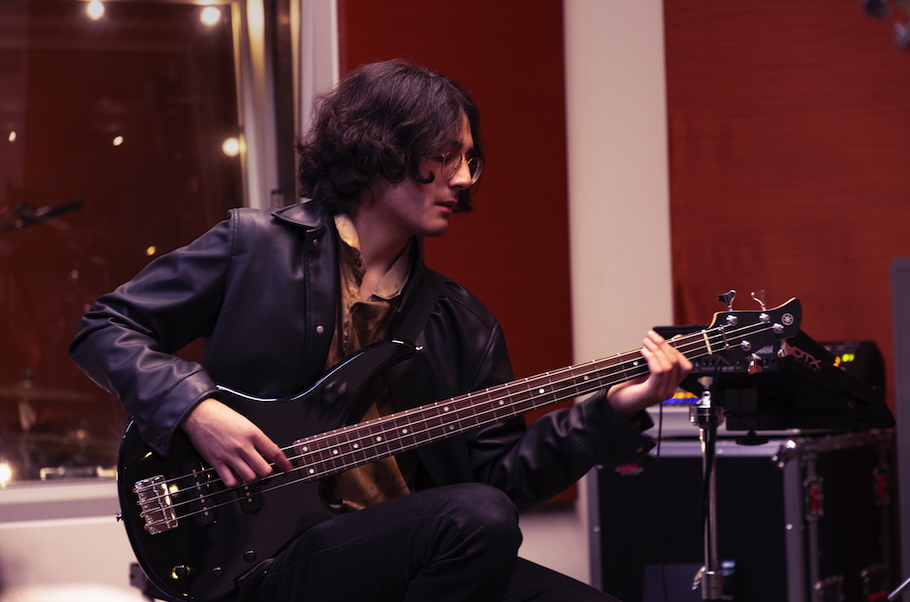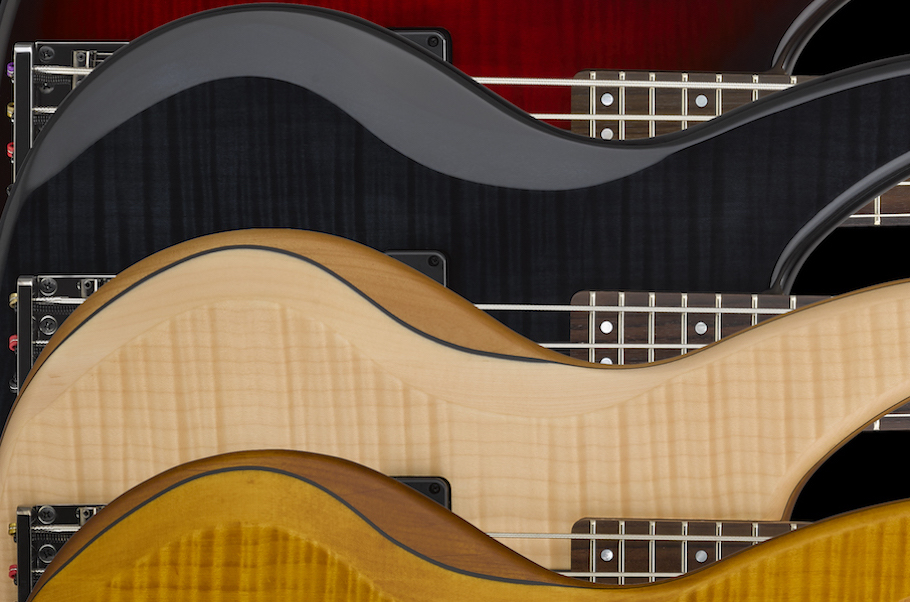Top 10 Bass Effects
Spice up your sound with these sonic embellishments.
Today’s bassist can choose from a wide array of effects specifically designed for the instrument. These can be used for everything from subtly spicing up your sound to modifying it dramatically. In this article, we’ll take a look at the top 10 bass effects, with descriptions of what they do, as well as audio examples so you can hear how they alter the sound.
1. Compression
Compression is perhaps the most subtle, yet most important bass effect there is. Some players use it to smooth out their dynamics; others lean on it to create a consistently beefy sound with gobs of sustain. Either way — especially if you’re recording or playing in a band situation — compression is a must.
To demonstrate, here’s a bass line completely dry, without any compression (or any effects of any kind). We’ll be using this as the basis for all the audio examples in this article.
Here it is with some judicious compression applied:
2. Distortion / Bit Crusher
When you play your bass too hard, push your amp beyond its capacity or use speakers that can’t handle your amp’s power output, you get bad distortion. But intentional distortion can be your friend. Maybe add a hint of grit based on the sensitivity of your attack, like in the Yes song “Heart of the Sunrise,” or try slathering on a layer of harmonic fuzz to boost a bass solo, as in “Dance to the Music” by Sly & the Family Stone:
Alternatively, you can dial in some heavily saturated sludge to take things to 11, like Muse’s “Hysteria”:
A subset of this is the bit crusher effect, which is a relatively new entry to the world of distortion — one that proves the axiom that less is more. It works its magic by reducing sample rate and resolution to degrade your sound by degrees until it literally becomes harsh and potentially unrecognizable. As an example, listen to “Davidian Dream Beam” by The Black Heart Death Cult.
3. Chorus
This effect subtly delays the timing of your original signal, then modulates the delay repetitively with a low frequency oscillator (LFO). In small doses, chorusing adds a secret sauce of depth and thickness to your sound without calling attention to itself. When pushed hard, chorus becomes almost breathy and metallic in a quintessential ’80s rock way, as embodied by Peter Hook’s bassline on New Order’s “Age of Consent.”
4. Flanger
Similar to chorus, but with shorter delay times, a flanger creates a duplicate version of your original signal, then varies the pitch. Faster flanging speeds result in a more dramatic sweeping sound. Check out Tool’s “Forty Six & 2” for a full-on flanger attack.
5. Phaser
Phasing is what happens when you take two identical signals and delay one of them slightly. To my ears, using a phaser adds a gentle psychedelic sweep to whatever you’re playing, and works best on repetitive phrases when the rate and depth roughly match the tempo of the song. I particularly like the gummy sound that’s created when the sweep reaches its maximum point and spins back around for its return trip. Looking for a masterclass in using phaser on bass? Listen to The O’Jays “For the Love of Money.”
6. Octave Divider
This takes your bassline and adds one or even two octaves above and/or below what you’re playing. On some older octave pedals, when you turn off your dry signal completely and only use the wet signal, the resulting sound is similar to a ’70s monophonic synth, as you can hear on The Kandinsky Effect’s “Somnambulist.”
It is, however, easier for octave dividers to faithfully track higher notes than lower ones, where there can sometimes be a slight delay or even a failure to track the note at all. To some players, that quirkiness sounds like an unacceptable mistake; to others, it’s an idiosyncrasy that adds flavor to a bassline. No matter what your tastes are, keep in mind that most amps and cabinets struggle to reproduce super-low frequencies (say, those below 30 Hz), so you need to use this effect sparingly when you start thumping around below low G or no one — including you — will hear it. And your speakers will likely suffer for it too.
7. Harmonizer
This effect adds an interval (major, minor, second through seventh and even octaves) above and/or below whatever you’re playing. When overused, a harmonizer can turn into a distraction, but when used tastefully it can turn the bassist of a power trio into a veritable string section. If you’ve ever worried that your bass sounds thin, a harmonizer might just be the missing link you’ve been searching for to put a little more backbone into your sound. That’s how a two-piece bass and drums outfit like Royal Blood can sound like an army on a track like “Out of the Black.”
8. Delay
Delay comes in many flavors. All are based on the concept of creating a copy of the original signal, and as a rule, most give you control over parameters that affect the speed, depth, tone and repetition of the delayed signal.
Short delays work well on bass, adding a nice sense of space, as you can hear in this audio clip:
That said, I’ve always been a sucker for reverb, which is a specific type of delay (or more correctly, series of delays) that emulates the natural sound bouncing around a room. My personal favorite is plate reverb — the result of a signal exciting a large metal plate — but you have to be cautious in its use, since too much reverb of any kind applied to bass can quickly muddy up a mix … unless you play fretless solos or are a member of an indie shoegaze band, in which case reverb is pretty much expected on everything.
In some circumstances, a better bet might be to use a digital emulation of a vintage analog tape delay machine. These relics of the recording studio used the time delay between the record head and the play head on a tape machine to create cool dub effects and relied on speed imperfections and tape saturation to create warbly delay effects. However, to use this effectively (pardon the pun), you need to be in a situation with lots of space to let the delays “breathe” and not obscure one another. You can find a good example of the use of tape delay applied to bass on the Pink Floyd track “One of These Days,” which was recorded in 1971, long before the days of digital.
9. Ring Modulation
If you love unearthly, grainy sounds, ring modulation may be your ticket to ride. But to understand how it works, please pull out your trigonometry calculator and sit up straight in your seat. Ring modulation takes your original bass signal (the “modulator” wave) and combines it with a “carrier” wave (generated by the effect itself) to create two new signals (the sum and the difference between the modulator and carrier waves), then subtracts the original signal from the mix. Does your head hurt? Mine too.
But don’t focus on the what or how, just know that ring modulation can create gripping, otherworldly tones that can’t be created any other way. However, the line between magic and tragic here is very fine; the trick is to blend in its output sparingly with your original signal. Listen to the song “Alpha and Omega” on Donny McCaslin’s album Casting for Gravity for an example of how to use ring modulation tastefully.
10. Envelope Filter
This highly responsive and complex effect is synonymous with funk and disco, and in the right hands (and even the wrong ones, sometimes) it sounds like a bass trying to speak actual words — skrank, mwowt-mwowt — even though the words would be considered nonsense. (Check out Thundercat’s “Them Changes” for a dose of funky gibberish.)
Numerous controls for various parameters make this challenging to quickly explain, but basically, envelope filters take what you play and how you play and use that information to control how certain frequencies pass through a sweeping filter while others are removed by it. As with ring modulators, don’t let the science scare you off. Once you balance the sensitivity of the effect with your bass signal and your overall attack, all the other controls start to reveal themselves. And, as a bonus, this is the only bass effect that, when used correctly, allows the player to wear ridiculous outfits onstage without actually being ridiculed. Trust me, it’s worth it: that resonant sound is unlike anything else.
Any of these effects can be used in combination with one another for even more complex tone shaping. Try, for example, applying some reverb to a chorused bass, or adding a touch of distortion to a harmonized bass sound before routing the signal into an envelope filter. You may need to do some experimentation to set levels correctly, and determining the order of the effects in your signal chain is a whole other topic for discussion. But don’t be timid about trying things out; after all, beautiful accidents are how new sounds are discovered. The only limit here is your imagination!














